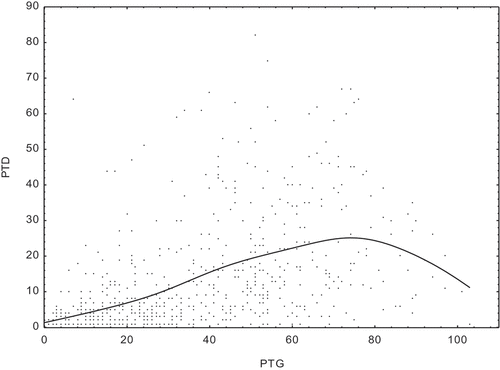Figures & data
Table 1. Respondent characteristics, at T1 (%), n = 848.
Table 2. Posttraumatic growth (PTG) and posttraumatic depreciation (PTD) at T2 according to single exposure and combinations of exposure, mean and standard deviation (SD), n = 848.
Figure 1. The association between the total score for posttraumatic growth (PTG) and posttraumatic depreciation (PTD).

Table 3. Means, standard deviations (SD), Cronbach’s α, and correlations between General Health Questionnaire (GHQ-12), Impact of Event Scale Revised (IES-R) at T1 and posttraumatic growth (PTG), and posttraumatic depreciation (PTD) at T2.
Table 4. Geometric mean ratio for reporting posttraumatic growth (PTG) and posttraumatic depreciation (PTD) at T2 according to different types of exposure, and co-variates at T1.
Table 5. Bayesian pathway analysis with general psychological distress (GHQ-12) and posttraumatic stress symptoms (IES-R), 14 months post-disaster (T1), as mediator variables for the outcome variables, posttraumatic growth (PTG) and posttraumatic depreciation (PTD), six years post-disaster (T2). To estimate direct and indirect effects, the three categorized variables gender, age and exposure were used in the statistical models. Significant indirect effect coefficients with 95% confidence interval are presented.
